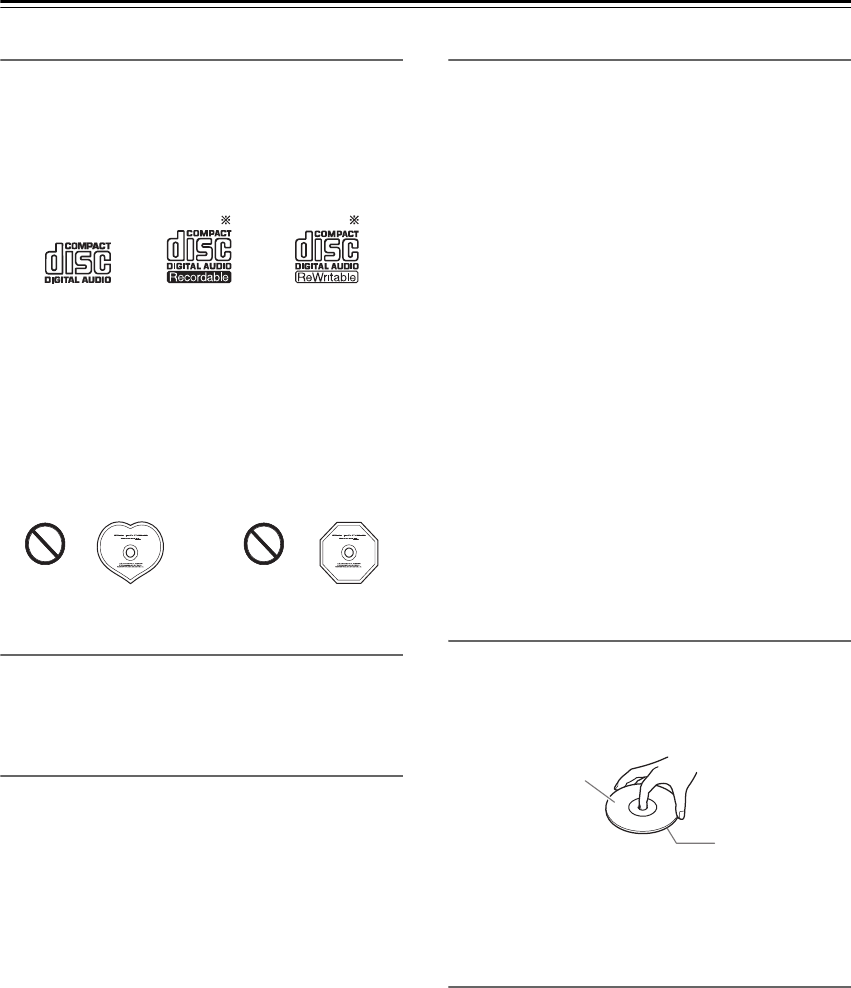
12
Disc (Audio CD and MP3) and USB Flash Drive
(MP3) Notes
Precautions for Playback
Compact discs (CDs) with the following logo on the
label surface can be used.
Do not use discs designed for purposes other than audio,
such as CD-ROMs for PC use. Abnormal noise could
damage the CD receiver.
* The CD receiver supports CD-R and CD-RW discs.
Note that some discs may not playback because of the disc
characteristics, scratches, contamination or the recording state.
A disc recorded with an audio CD record will not playback
unless it is finalized.
Never use discs which have a special shape (such as
hearts or octagons). These types of discs could jam and
damage the CD receiver.
CD Playback with Copy-control Function
Some audio CDs with copy-control function do not
comply with official CD standards. These are special
discs and cannot be played with the CD receiver.
Playback of MP3 Discs
MP3 files recorded on a CD-R/CD-RW can be played
with the CD receiver.
• Use discs which have been recorded following the
ISO 9660 Level 2 file system. (The supported
directory depth is eight levels, the same as ISO 9660
Level 1)
• Discs recorded with the hierarchical file system (HFS)
cannot be played.
• Discs must be closed (finalized).
• Only MP3 files with the extension “.MP3” or “. mp3”
are supported.
• Files recorded using MPEG 1 audio layer 3 at
sampling frequencies of 32/44.1/48 kHz and a
constant bit rate (CBR) of 32–320 kbps are supported.
• A maximum of 299 folders can be recognized on a
single CD. A maximum of 648 files can be recognized
in a single folder.
Playback from USB Flash Drives
MP3 files recorded on a USB flash drive can be played
with the CD receiver.
• USB flash drives formatted in FAT16 or FAT32 are
supported.
• Only MP3 files with the extension “.MP3” or “.mp3”
are supported.
• Files recorded using MPEG 1 audio layer 3 at
sampling frequencies of 32/44.1/48 kHz and a
constant bit rate (CBR) of 32–320 kbps are supported.
• A maximum of 299 folders can be recognized on a
single USB flash drive. A maximum of 648 files can
be recognized in a single folder.
Note:
• A disc recorded with a recorder or personal computer
may not play in some cases. (Cause: Disc’s
characteristics, damaged or dirty disc, dirt on player’s
lens, dew condensation, etc.)
• A disc recorded on a personal computer may not play
because of the application settings or environment.
Record the disc with the proper format. (Contact the
application maker for details.)
• A disc with insufficient storage capacity may not
playback properly.
Handling Discs
Hold discs by the edge, or by the center hole and edge.
Avoid touching the playback surface (surface with
nothing printed on it).
Do not attach paper or stickers, or write on the playback
or label surface of the disc. Take care not to scratch or
damage the disc.
Precautions for Rental Discs
Do not use discs with residue from cellophane tape,
rental discs with labels which are peeling off, or discs
with decorative labels. This type of disc could get stuck
in the CD receiver, or could damage the CD receiver.
Label surface
(printed surface)
Playback surface


















